Chapter 9 Gases
Chapter 9 Problems
9.1 Gas Pressure
9.1. Why are sharp knives more effective than dull knives? (Hint: Think about the definition of pressure.)
9.2. Why do some small bridges have weight limits that depend on how many wheels or axles the crossing vehicle has?
9.3. Why should you roll or belly-crawl rather than walk across a thinly-frozen pond?
9.4. A typical barometric pressure in Redding, California, is about 750 mm Hg. Calculate this pressure in atm and kPa.
9.5.
9.6. A typical barometric pressure in Kansas City is 740 torr. What is this pressure in atmospheres, in millimeters of mercury, and in kilopascals?
9.7. Canadian tire pressure gauges are marked in units of kilopascals. What reading on such a gauge corresponds to 32 psi?
9.8. During the Viking landings on Mars, the atmospheric pressure was determined to be on average about 6.50 millibars (1 bar = 0.987 atm). What is that pressure in torr and kPa?
9.9. The pressure of the atmosphere on the surface of the planet Venus is about 88.8 atm. Compare that pressure in psi to the normal pressure on earth at sea level in psi.
9.10. A medical laboratory catalog describes the pressure in a cylinder of a gas as 14.82 MPa. What is the pressure of this gas in atmospheres and torr?
9.11. Consider this scenario and answer the following questions: On a mid-August day in the northeastern United States, the following information appeared in the local newspaper: atmospheric pressure at sea level 29.97 in. Hg, 1,013.9 mbar.
(a) What was the pressure in kPa?
(b) The pressure near the seacoast in the northeastern United States is usually reported near 30.0 in. Hg. During a hurricane, the pressure may fall to near 28.0 in. Hg. Calculate the drop in pressure in torr.
9.12. Why is it necessary to use a nonvolatile liquid in a barometer or manometer?
9.13. The pressure of a sample of gas is measured at sea level with a closed-end manometer. The liquid in the manometer is mercury. Determine the pressure of the gas in:
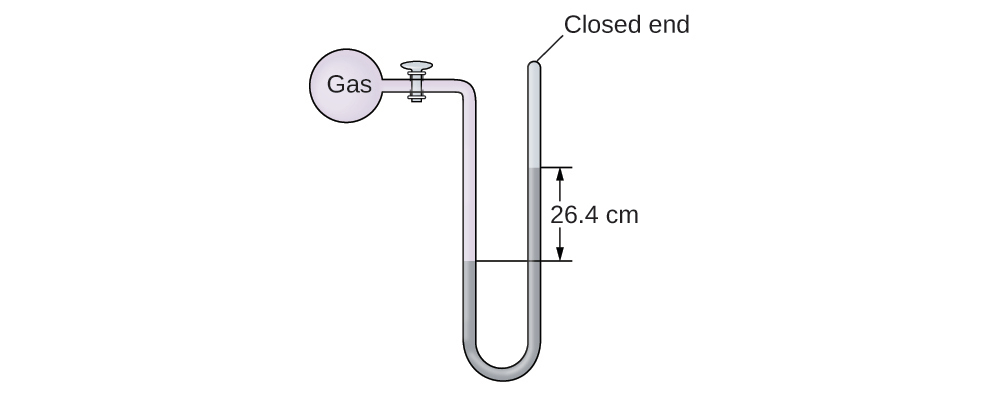
(a) torr
(b) Pa
(c) bar
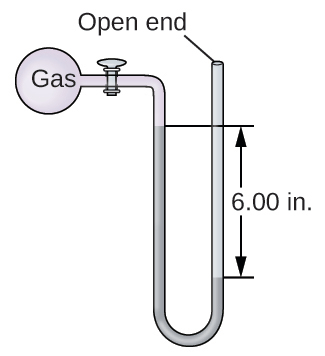
9.14. The pressure of a sample of gas is measured with an open-end manometer, partially shown to the right. The liquid in the manometer is mercury. Assuming atmospheric pressure is 29.92 in. Hg, determine the pressure of the gas in:
(a) torr
(b) Pa
(c) bar
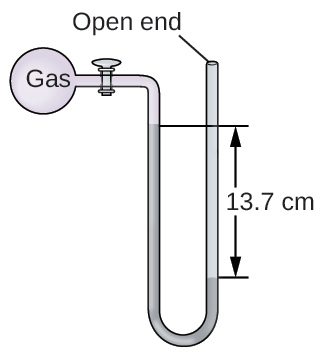
9.15. The pressure of a sample of gas is measured at sea level with an open-end mercury manometer. Assuming atmospheric pressure is 760.0 mm Hg, determine the pressure of the gas in:
(a) mm Hg
(b) atm
(c) kPa
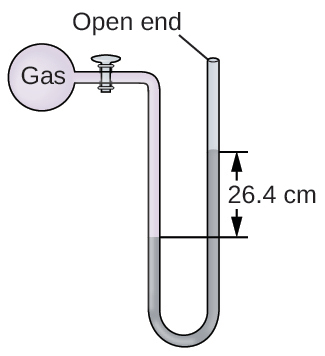
9.16. The pressure of a sample of gas is measured at sea level with an open-end mercury manometer. Assuming atmospheric pressure is 760 mm Hg, determine the pressure of the gas in:
(a) mm Hg
(b) atm
(c) kPa
9.17. How would the use of a volatile liquid affect the measurement of a gas using open-ended manometers versus closed-end manometers?
9.2 Relating Pressure, Volume, Amount, and Temperature: Gas Laws
9.18. Sometimes leaving a bicycle in the sun on a hot day will cause a blowout. Why?
9.19. Explain how the volume of the bubbles exhausted by a scuba diver (Figure 9.16) change as they rise to the surface, assuming that they remain intact.
9.20. One way to state Boyle’s law is “All other things being equal, the pressure of a gas is inversely proportional to its volume.” (a) What is the meaning of the term “inversely proportional?” (b) What are the “other things” that must be equal?
9.21. An alternate way to state Avogadro’s law is “All other things being equal, the number of molecules in a gas is directly proportional to the volume of the gas.” (a) What is the meaning of the term “directly proportional?” (b) What are the “other things” that must be equal?
9.22. How would the graph in Figure 9.12 change if the number of moles of gas in the sample used to determine the curve were doubled?
9.23. How would the graph in Figure 9.13 change if the number of moles of gas in the sample used to determine the curve were doubled?
9.24. In addition to the data found in Figure 9.13, what other information do we need to find the mass of the sample of air used to determine the graph?
9.25. Determine the volume of 1 mol of CH4 gas at 150 K and 1 atm, using Figure 9.12.
9.26. Determine the pressure of the gas in the syringe shown in Figure 9.13 when its volume is 12.5 mL, using:
(a) the appropriate graph
(b) Boyle’s law
9.27. A spray can is used until it is empty except for the propellant gas, which has a pressure of 1,344 torr at 23°C. If the can is thrown into a fire (T = 475°C), what will be the pressure in the hot can?
9.28. What is the temperature of an 11.2-L sample of carbon monoxide, CO, at 744 torr if it occupies 13.3 L at 55°C and 744 torr?
9.29.
9.30. A balloon inflated with three breaths of air has a volume of 1.7 L. At the same temperature and pressure, what is the volume of the balloon if five more same-sized breaths are added to the balloon?
9.3 The Ideal Gas Law
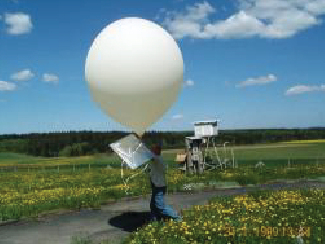
9.31. A weather balloon contains 8.80 moles of helium at a pressure of 0.992 atm and a temperature of 25°C at ground level. What is the volume of the balloon under these conditions?
9.32. The volume of an automobile air bag was 66.8 L when inflated at 25°C with 77.8 g of nitrogen gas. What was the pressure in the bag in kPa?
9.33. How many moles of gaseous boron trifluoride, BF3, are contained in a 4.3410-L bulb at 788.0 K if the pressure is 1.220 atm? How many grams of BF3?
9.34. Iodine, I2, is a solid at room temperature but sublimes (converts from a solid into a gas) when warmed. What is the temperature in a 73.3-mL bulb that contains 0.292 g of I2 vapor at a pressure of 0.462 atm?
9.35. How many grams of gas are present in each of the following cases?
(a) 0.100 L of CO2 at 307 torr and 26°C
(b) 8.75 L of C2H4, at 378.3 kPa and 483 K
(c) 221 mL of Ar at 0.23 torr and –54°C
9.36. A high-altitude balloon is filled with 1.41 × 104 L of hydrogen at a temperature of 21°C and a pressure of 745 torr. What is the volume of the balloon at a height of 20 km, where the temperature is –48°C and the pressure is 63.1 torr?
9.37.
9.38. A large scuba tank (Figure 9.16) with a volume of 18 L is rated for a pressure of 220 bar. The tank is filled at 20°C and contains enough air to supply 1,860 L of air to a diver at a pressure of 2.37 atm (a depth of 45 feet). Was the tank filled to capacity at 20°C?
9.39.
9.40. While resting, the average 70-kg human male consumes 14 L of pure O2 per hour at 25°C and 100 kPa. How many moles of O2 are consumed by a 70-kg man while resting for 1.0 h?
9.41. For a given amount of gas showing ideal behavior, draw labeled graphs of:
(a) the variation of P with V
(b) the variation of V with T
(c) the variation of P with T
(d) the variation of 1/P with V
9.42. A liter of methane gas, CH4, at STP contains more atoms of hydrogen than does a liter of pure hydrogen gas, H2, at STP. Using Avogadro’s law as a starting point, explain why.
9.43.
9.44. As 1 g of the radioactive element radium decays over 1 year, it produces 1.16 × 1018 alpha particles (helium nuclei). Each alpha particle becomes an atom of helium gas. What is the pressure in pascals of the helium gas produced if it occupies a volume of 125 mL at a temperature of 25°C?
9.45.
9.46. If the temperature of a fixed amount of a gas is doubled at constant volume, what happens to the pressure?
9.47. If the volume of a fixed amount of a gas is tripled at constant temperature, what happens to the pressure?
9.4 Applying the Ideal Gas Law
9.48. What is the density of laughing gas, dinitrogen monoxide, N2O, at a temperature of 325 K and a pressure of 113.0 kPa?
9.49.
9.50. Which is denser at the same temperature and pressure, dry air or air saturated with water vapor? Explain.
9.51.
9.52. What is the molar mass of a gas if 0.0494 g of the gas occupies a volume of 0.100 L at a temperature 26°C and a pressure of 307 torr?
9.53.
9.54. How could you show experimentally that the molecular formula of propene is C3H6, not CH2?
9.55.
9.56. Consider this question: What is the molecular formula of a compound that contains 39% C, 45% N, and 16% H if 0.157 g of the compound occupies l25 mL with a pressure of 99.5 kPa at 22°C?
(a) Outline the steps necessary to answer the question.
(b) Answer the question.
9.5 Stoichiometry of Gaseous Substances, Mixtures, and Reactions
9.57. A 36.0-L cylinder of a gas used for calibration of blood gas analyzers in medical laboratories contains 350 g CO2, 805 g O2, and 4,880 g N2. At 25 degrees C, what is the pressure in the cylinder in atmospheres?
9.58. A cylinder of a gas mixture used for calibration of blood gas analyzers in medical laboratories contains 5.0% CO2, 12.0% O2, and the remainder N2 at a total pressure of 146 atm. What is the partial pressure of each component of this gas? (The percentages given indicate the percent of the total pressure that is due to each component.)
9.59.
9.60. A mixture of 0.200 g of H2, 1.00 g of N2, and 0.820 g of Ar is stored in a closed container at STP. Find the volume of the container, assuming that the gases exhibit ideal behavior.
9.61.
9.62. A commercial mercury vapor analyzer can detect, in air, concentrations of gaseous Hg atoms (which are poisonous) as low as 2 × 10−6 mg/L of air. At this concentration, what is the partial pressure of gaseous mercury if the atmospheric pressure is 733 torr at 26°C?
9.63.
9.64. In an experiment in a general chemistry laboratory, a student collected a sample of a gas over water. The volume of the gas was 265 mL at a pressure of 753 torr and a temperature of 27°C. The mass of the gas was 0.472 g. What was the molar mass of the gas?
9.65. Joseph Priestley first prepared pure oxygen by heating mercuric oxide, HgO:
2 HgO(s) → 2 Hg(l) + O2(g)
(a) Outline the steps necessary to answer the following question: What volume of O2 at 23°C and 0.975 atm is produced by the decomposition of 5.36 g of HgO?
(b) Answer the question.
9.66. Cavendish prepared hydrogen in 1766 by the novel method of passing steam through a red-hot gun barrel:
4 H2O(g) + 3 Fe(s) → Fe3O4(s) + 4 H2(g)
(a) Outline the steps necessary to answer the following question: What volume of H2 at a pressure of 745 torr and a temperature of 20°C can be prepared from the reaction of 15.O g of H2O?
(b) Answer the question.
9.67. The chlorofluorocarbon CCl2F2 can be recycled into a different compound by reaction with hydrogen to produce CH2F2(g), a compound useful in chemical manufacturing:
CCl2F2(g) + 4 H2(g) → CH2F2(g) + 2 HCl(g)
(a) Outline the steps necessary to answer the following question: What volume of hydrogen at 225 atm and 35.5°C would be required to react with 1 ton (1.000 × 103 kg) of CCl2F2?
(b) Answer the question.
9.68. Automobile air bags are inflated with nitrogen gas, which is formed by the decomposition of solid sodium azide (NaN3). The other product is sodium metal. Calculate the volume of nitrogen gas at 27°C and 756 torr formed by the decomposition of 125 g of sodium azide.
9.69. Lime, CaO, is produced by heating calcium carbonate, CaCO3; carbon dioxide is the other product.
(a) Outline the steps necessary to answer the following question: What volume of carbon dioxide at 875 K and 0.966 atm is produced by the decomposition of 1 ton (1.000 × 103 kg) of calcium carbonate?
(b) Answer the question.
9.70. Before small batteries were available, carbide lamps were used for bicycle lights. Acetylene gas, C2H2, and solid calcium hydroxide were formed by the reaction of calcium carbide, CaC2, with water. The ignition of the acetylene gas provided the light. Currently, the same lamps are used by some cavers, and calcium carbide is used to produce acetylene for carbide cannons.
(a) Outline the steps necessary to answer the following question: What volume of C2H2 at 1.005 atm and 12.2°C is formed by the reaction of 15.48 g of CaC2 with water?
(b) Answer the question.
9.71.
9.72. What volume of O2 at STP is required to oxidize 8.0 L of NO at STP to NO2? What volume of NO2 is produced at STP?
9.73.
9.74. Methanol, CH3OH, is produced industrially by the following reaction:
CO(g) + 2 H2(g) [latex]\xrightarrow [300^\circ C, \; 300 \: atm] {copper \; catalyst}[/latex] CH3OH(g)
Assuming that the gases behave as ideal gases, find the ratio of the total volume of the reactants to the final volume.
9.75.
9.76. A 2.50-L sample of a colorless gas at STP decomposed to give 2.50 L of N2 and 1.25 L of O2 at STP. What is the colorless gas?
9.77. Ethanol, C2H5OH, is produced industrially from ethylene, C2H4, by the following sequence of reactions:
3 C2H4 + 2 H2SO4 → C2H5HSO4 + (C2H5)2SO4
What volume of ethylene at STP is required to produce 1.000 metric ton (1,000 kg) of ethanol if the overall yield of ethanol is 90.1%?
9.78. One molecule of hemoglobin will combine with four molecules of oxygen. If 1.0 g of hemoglobin combines with 1.53 mL of oxygen at body temperature (37°C) and a pressure of 743 torr, what is the molar mass of hemoglobin?
9.79.
9.80. One method of analyzing amino acids is the van Slyke method. The characteristic amino groups (−NH2) in protein material are allowed to react with nitrous acid, HNO2, to form N2 gas. From the volume of the gas, the amount of amino acid can be determined. A 0.0604-g sample of a biological sample containing glycine, CH2(NH2)COOH, was analyzed by the van Slyke method and yielded 3.70 mL of N2 collected over water at a pressure of 735 torr and 29°C. What was the percentage of glycine in the sample?
CH2(NH2)CO2H + HNO2 → CH2(OH)CO2H + H2O + N2
9.6 Effusion and Diffusion of Gases
9.81.
9.82. Explain why the numbers of molecules are not identical in the left- and right-hand bulbs shown in the center illustration of Figure 9.29.
9.83. Starting with the definition of rate of effusion and Graham’s finding relating rate and molar mass, show how to derive the Graham’s law equation, relating the relative rates of effusion for two gases to their molecular masses.
9.84. Heavy water, D2O (molar mass = 20.03 g mol–1), can be separated from ordinary water, H2O (molar mass = 18.01), as a result of the difference in the relative rates of diffusion of the molecules in the gas phase. Calculate the relative rates of diffusion of H2O and D2O.
9.85.
9.86. During the discussion of gaseous diffusion for enriching uranium, it was claimed that 235UF6 diffuses 0.4% faster than 238UF6. Show the calculation that supports this value. The molar mass of 235UF6 = 235.043930 + 6 × 18.998403 = 349.034348 g/mol, and the molar mass of 238UF6 = 238.050788 + 6 × 18.998403 = 352.041206 g/mol.
9.87. Calculate the relative rate of diffusion of 1H2 (molar mass 2.0 g/mol) compared with 2H2 (molar mass 4.0 g/mol) and the relative rate of diffusion of O2 (molar mass 32 g/mol) compared with O3 (molar mass 48 g/mol).
9.88. A gas of unknown identity diffuses at a rate of 83.3 mL/s in a diffusion apparatus in which carbon dioxide diffuses at the rate of 102 mL/s. Calculate the molecular mass of the unknown gas.
9.89. When two cotton plugs, one moistened with ammonia and the other with hydrochloric acid, are simultaneously inserted into opposite ends of a glass tube that is 87.0 cm long, a white ring of NH4Cl forms where gaseous NH3 and gaseous HCl first come into contact.
NH3(g) + HCl(g) → NH4Cl(s)
At approximately what distance from the ammonia moistened plug does this occur? (Hint: Calculate the rates of diffusion for both NH3 and HCl, and find out how much faster NH3 diffuses than HCl.)
9.7 The Kinetic-Molecular Theory
9.90. Using the postulates of the kinetic molecular theory, explain why a gas uniformly fills a container of any shape.
9.91. Can the speed of a given molecule in a gas double at constant temperature? Explain your answer.
9.92. Describe what happens to the average kinetic energy of ideal gas molecules when the conditions are changed as follows:
(a) The pressure of the gas is increased by reducing the volume at constant temperature.
(b) The pressure of the gas is increased by increasing the temperature at constant volume.
(c) The average speed of the molecules is increased by a factor of 2.
9.93. The distribution of molecular speeds in a sample of helium is shown in Figure 9.36. If the sample is cooled, will the distribution of speeds look more like that of H2 or of H2O? Explain your answer.
9.94. What is the ratio of the average kinetic energy of a SO2 molecule to that of an O2 molecule in a mixture of two gases? What is the ratio of the root mean square speeds, urms, of the two gases?
9.95. A 1-L sample of CO initially at STP is heated to 546 K, and its volume is increased to 2 L.
(a) What effect do these changes have on the number of collisions of the molecules of the gas per unit area of the container wall?
(b) What is the effect on the average kinetic energy of the molecules?
(c) What is the effect on the root mean square speed of the molecules?
9.96. The root mean square speed of H2 molecules at 25°C is about 1.6 km/s. What is the root mean square speed of a N2 molecule at 25°C?
9.97. Answer the following questions:
(a) Is the pressure of the gas in the hot-air balloon shown at the opening of this chapter greater than, less than, or equal to that of the atmosphere outside the balloon?
(b) Is the density of the gas in the hot-air balloon shown at the opening of this chapter greater than, less than, or equal to that of the atmosphere outside the balloon?
(c) At a pressure of 1 atm and a temperature of 20°C, dry air has a density of 1.2256 g/L. What is the (average) molar mass of dry air?
(d) The average temperature of the gas in a hot-air balloon is 1.30 × 102°F. Calculate its density, assuming the molar mass equals that of dry air.
(e) The lifting capacity of a hot-air balloon is equal to the difference in the mass of the cool air displaced by the balloon and the mass of the gas in the balloon. What is the difference in the mass of 1.00 L of the cool air in part (c) and the hot air in part (d)?
(f) An average balloon has a diameter of 60 feet and a volume of 1.1 × 105 ft3. What is the lifting power of such a balloon? If the weight of the balloon and its rigging is 500 pounds, what is its capacity for carrying passengers and cargo?
(g) A balloon carries 40.0 gallons of liquid propane (density 0.5005 g/L). What volume of CO2 and H2O gas is produced by the combustion of this propane?
(h) A balloon flight can last about 90 minutes. If all of the fuel is burned during this time, what is the approximate rate of heat loss (in kJ/min) from the hot air in the bag during the flight?
9.98. Show that the ratio of the rate of diffusion of Gas 1 to the rate of diffusion of Gas 2, R1/R2, is the same at 0°C and 100°C.
9.8 Non-Ideal Gas Behavior
9.99. Graphs showing the behavior of several different gases follow. Which of these gases exhibit behavior significantly different from that expected for ideal gases?
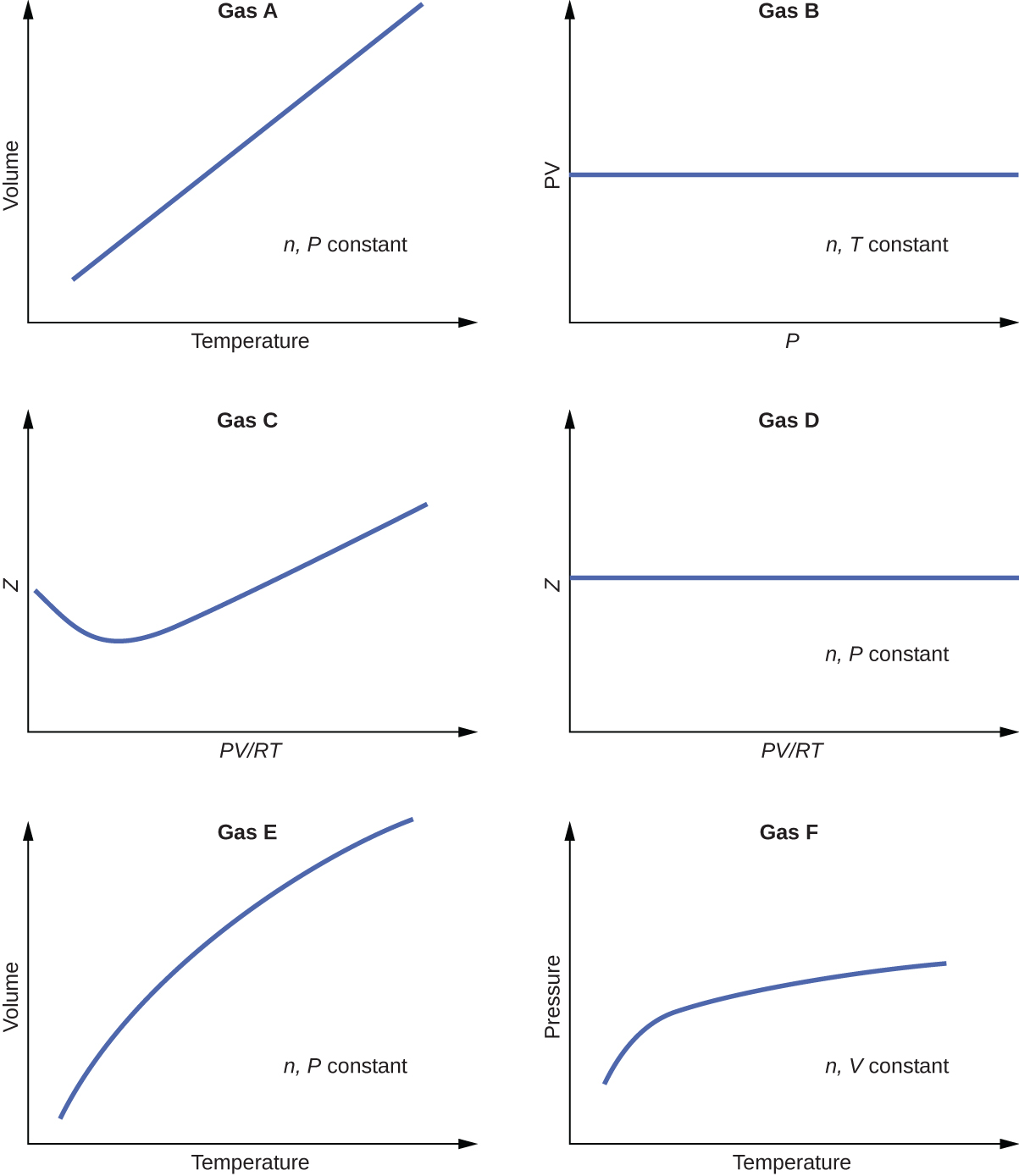
9.100. Explain why the plot of PV for CO2 differs from that of an ideal gas.
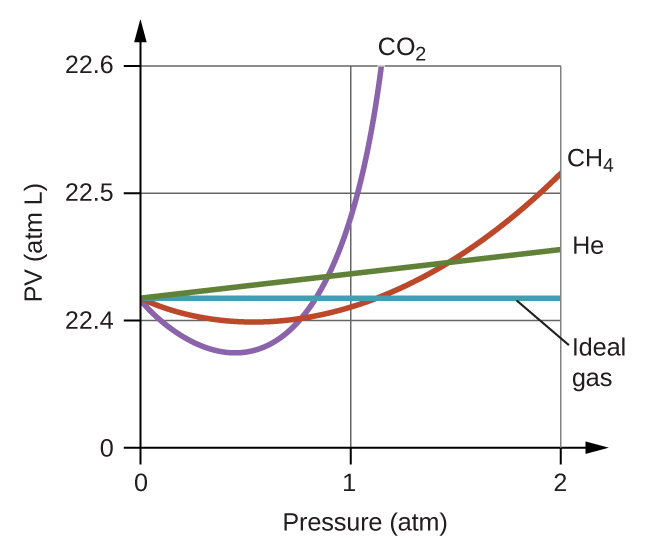
9.101. Under which of the following sets of conditions does a real gas behave most like an ideal gas, and for which conditions is a real gas expected to deviate from ideal behavior? Explain.
(a) high pressure, small volume
(b) high temperature, low pressure
(c) low temperature, high pressure
9.102. Describe the factors responsible for the deviation of the behavior of real gases from that of an ideal gas.
9.103.
9.104. A 0.245-L flask contains 0.467 mol CO2 at 159°C. Calculate the pressure:
(a) using the ideal gas law
(b) using the van der Waals equation
(c) Explain the reason for the difference.
(d) Identify which correction (that for P or V) is dominant and why.
9.105. Answer the following questions:
(a) If XX behaved as an ideal gas, what would its graph of Z versus P look like?
(b) For most of this chapter, we performed calculations treating gases as ideal. Was this justified?
(c) What is the effect of the volume of gas molecules on Z? Under what conditions is this effect small? When is it large? Explain using an appropriate diagram.
(d) What is the effect of intermolecular attractions on the value of Z? Under what conditions is this effect small? When is it large? Explain using an appropriate diagram.
(e) In general, under what temperature conditions would you expect Z to have the largest deviations from the Z for an ideal gas?
Cumulative
9.106. Hydrogen can be used as an alternative fuel for vehicles. Let's figure out how much hydrogen gas will be needed to provide the same amount of energy that comes from gasoline combustion if an average 10-gallon gasoline tank can provide a total of 1.295 gigajoules of combustion energy.
9.107. Nitric acid forms in the atmosphere from nitrogen dioxide, a byproduct of high-temperature combustion via this reaction:
4 NO2(g) + O2(g) + 2 H2O(g) → 4 HNO3(aq)
9.108. Cobalt (III) carbonate reacts with hydrochloric acid according to the equation below.
Co2(CO3)3(s) + 6 HCl(aq) → 2 CoCl3(aq) + 3 CO2(g) + 3 H2O(l)
(a) Give the net ionic equation.
(b) How much concentrated HCl (11.7 M) must be used to prepare 500.00 mL of 1.25 M HCl?
(c) Determine the limiting reagent when 1.067 g Co2(CO3)3 reacts with 22.27 mL 1.25 M HCl.
(d) What concentration of HCl remains at the end of the reaction? Assume the volume remains constant.
(e) What concentration of CoCl3 forms?
(f) Calculate the volume occupied by the carbon dioxide that forms at 32°C and 216 kPa?
9.109. A 0.810-L sample of C3H8 at 5.67 atm and 16°C reacts with 20.8 L steam at 1,350 Torr and 145oC.
C3H8(g) + 3 H2O(g) → 3 CO(g) + 7 H2(g)
(a) Determine the limiting reagent.
(b) How much (in mol) of the excess reagent remains?
(c) How much (in mol) of the products form?
(d) Given that the pressure at the end of the reaction is 178 kPa, what is the partial pressure of carbon monoxide? (Hint: What species would be present at the end of the reaction?)
9.110. In June 20, 2017, in Phoenix, Arizona, the temperature climbed so high that flights had to be canceled. Given that at the peak, temperature and atmospheric pressure reached 119°F (48°C) and 29.6 in Hg (751 Torr), what was the atmospheric density (29.0 g/mol)?
9.111. In this question, let’s explore the atmospheres of other planets in our solar system.
(a) The atmosphere on Venus has a composition of 96% carbon dioxide and 4% nitrogen. The pressure and density are 92 atm and 65 kg/m3, respectively. Using pure carbon dioxide as an approximation, estimate the atmospheric temperature on Venus.
(b) Martian atmosphere is recreated in a lab using 3.52 × 10–4 mol carbon dioxide, 9.6 × 10–6 mol nitrogen, 7.0 × 10–6 mol argon and 5.9 × 10–7 mol oxygen. Determine percent composition of Martian atmosphere and the atmospheric pressure given that argon exerts 1.2 × 10–4 atm.
(c) Jupiter’s atmosphere is 89.8% hydrogen and 10.2% helium. Calculate the moles of each gas that would be in a 100. mL sample of Jovian atmosphere given that at its minimum, it is at 0.1 atm and 110. K. How fast are the gases moving on Jupiter compared to on Earth, where the average atmospheric temp is 15°C?
9.112. Leavening agents are used in baking to give volume and airiness to the baked goods.
- In yeasted bakes, the yeast metabolizes sugar and flour to produce carbon dioxide.
- In meringue, egg white is whipped until firm, which traps air.
- Baking soda or powder produces carbon dioxide when bicarbonate reacts with acid.
Regardless of how they are produced, how do the leavening agents lead to “rise” of the baked goods?
9.113. As we learned in Section 7.7, molecules only need to have a dipole at some point in their vibrations to absorb infrared radiation (IR). Our two-dimensional way of thinking (just drawing a Lewis structure on paper) is not sufficient to understand polarity. Think about the molecule bending, stretching, and moving around to shift electron density around and induce a dipole. Carbon dioxide is "nonpolar" on paper yet "polar" when bent or stretched asymmetrically. Once a greenhouse gas absorbs IR, it will emit IR based on its own temperature; the amount of energy emitted depends on the molecule's temperature. Closer to the surface, molecules are warmer, and thus emit more IR. Temperature also affects density.
(a) Calculate the density of carbon dioxide (a prominent greenhouse gas) at a high altitude and a low altitude.
| High Altitude | Low Altitude |
| 12 km | 1 km |
| -55°C | 8.5°C |
| 0.173 atm | 0.886 atm |
